The Javascript Tabs-Based Editor provides an easy-to-use layout for entering different components to a teaching file case. There are separate tabs for Case Properties, Case Text, Case Images, File Upload, and DICOM Queue. By clicking on each tab you will be presented with a form to either enter case information or add images. Be sure that you have an account and are logged in.
- After clicking on "Create New Case"
from the Case Manager the Tabs-Based Editor will load in your browser.

- Once the editor has loaded the DICOM
tab will be the default selection. There is no determined order in
creating the teaching file case, so simply click any tab to begin
entering case data or images.
You can fill out as much of the case forms as you like, and come back later to complete it. Case fields are optional unless they are marked with a red asterix (*). Your administrator determines whether each field is optional, required, or disabled. Disabled fields will not appear in the case editor.
- The DICOM tab lets you search the DICOM Queue for
studies that have been pushed from your PACS workstation to the Teaching
File server. After a study has been located you can view the images
in our built-in DICOM Viewer. You can also change the windows and
levels settings while viewing the series. With a click of a button
you can add any image in a series to the teaching file case. The DICOM
Queue stores the study Header information so when an image is selected
for a teaching file case the system will auto-populate the patient
information fields from the Case Properties form.
• The default view of the DICOM tab will show the most recent studies that have been sent from the PACS workstation to the Teaching File DICOM Queue.
• You can search for your study by entering the patients first or last name, the patients hospital number, or the Accession number. Studies must be pushed from the PACS workstation to the DICOM Queue before they can be searched on. You cannot search and retrieve from your instution's PACS system. Once you have entered your search criteria you can press the "Search" button. If you want to see all of the studies that are in the DICOM Queue then press the "show all series " link above the search box.
• After you have entered your search parameters and pressed the "Search" button the server will display matched studies. Search results will be listed by patient name in alphabetical order. Also included with each result is a patient number, study number, date and time study was created, and the type of study. You will also see blue text which provides a link to view a series associated with a particluar study. Each linked series will show the series number, the number of images in the series, and the date it was pushed to the DICOM Queue. To load a series click on the series number.

• After you load a series it will open in a built-in DICOM viewer. The viewer allows you to select an image from the series to include in the teaching file case, adjust the windows and levels of an image or the entire series, and to auto-populate study information into the teaching file case.

- Select an Image: use your mouse pointer to move the slider bar and cycle through series' images (a mouse's scroll wheel will move through the series' images as well). You can also use the "Prev" and "Next" buttons to move up or down one image at a time. If you want to add an image to a teaching file case press the "Add Image to Case" button while the image is being displayed in the viewer.
- Windows and Levels: you can change the windows and levels settings by choosing presets from the drop-down menu or enter specific values into the "W" and "L" fields. Select if you want the change to be applied to the single image being displayed or to the entire series. After making your changes press the "Adjust W/L" button for changes to be applied.
- Study Information: when you first add an image to a case from a DICOM study the patient
information contained in the study header automatically gets populated in the corresponding Case Property fields. Once the fields have been populated you will have the option to override them and/or add additional values. To do this click the 'Manually import additional info' link under the "Add Image to Case" button on Dicom Viewer to display the Populate Case window.
The Dicom Value column shows information assigned t the loaded series. The Current Value column shows information currently in the teaching file case. To auto-populate the teaching file case with all the Dicom values check the "Select all fields" box and press the "Submit Selected Fields" button. If you only want specific Dicom values to be added to the teaching file case check the designated boxes next to the desired information and then press the "Submit Selected Fields" button.

After pressing the "Submit Selected Fields" button you will be taken to the Case Properties tab, where you will notice that the appropriate fields have automatically been filled in with the Dicom values.
- The Case Properties tab allows you to enter a
title for the case, set permission values, enter patient information,
indicate exam date, modalities used, and anatomy and pathology classifications.
You can also enter ACR codes and searchable keywords.
• Enter a descriptive title. The title will appear at the top of the case and in the case abstract when training mode is not turned on. It is OK to mention the diagnosis in the title -- you won't be giving away the answer because the title will be hidden when users are viewing the case as an unknown.

• Use the drop down menus to specify access control settings. Set Readable By to "Owner Only" if you want the case to be private. Set it to "All Users" if you want to share it with the public. If you belong to any groups, you can also specify group-level sharing.

Set Writable By to "Owner Only" if you do not want other users to be able to edit your case. Alternatively, you can specify that the case is writable by members of a group you belong to. If the Writable By field does not show up, it means you do not belong to any groups. See Managing Groups for more information.
• Enter patient information. If your system allows patient identifiers, you may be prompted to enter a name and patient number, which are useful for performing followup studies. To protect patient privacy, the patient name and number will be hidden from users other than the case author and administrator. Whenever someone visits the case, the system will keep a log of whether or not the patient information has been displayed. You may also be prompted for demographic information such as the age and gender.
• You may enter additional information about the case, including the exam date, modalities, pathology, anatomy, keywords, and ACR codes. Your case will be classified according to the values you select using the dropdown menus for pathology and anatomy. The more information you fill out, the easier it will be for users to find your case using the Advanced Search form.

- The Case Text tab allows you to add text for the
case, including history, findings, diagnosis, discussion,
and references if available.

If you prefer, you can report findings in the image captions instead of in the general findings field (see: Adding Images to a Case). All the case text will be indexed by the database search engine. The various fields will be revealed incrementally when your case is viewed with training mode turned on.
Optionally, you may enter private notes. This field will be hidden from other users. This field is searchable by you, so you can use it to add special tags or keywords for your own personal filing system.

Each text field is equipped with a full HTML editor allowing you to easily control fonts, add hyperlinks, copy, cut and paste text, control justification, and create ordered and unordered lists.
 Text Control: Allows you to bold, italisize,
and underline text.
Text Control: Allows you to bold, italisize,
and underline text.
 Hyperlink: Allows you to select and link some text to
a specific URL. After selecting the text by left-clicking and
dragging your mouse over the desired text click the hyperlink
icon shown above. A window will pop-up asking for the linked web
address. You can also specify for the linked address to open in
a new browser window by using the "Target" drop-down
menu.
Hyperlink: Allows you to select and link some text to
a specific URL. After selecting the text by left-clicking and
dragging your mouse over the desired text click the hyperlink
icon shown above. A window will pop-up asking for the linked web
address. You can also specify for the linked address to open in
a new browser window by using the "Target" drop-down
menu.
 Content: Allows you to copy, cut, and paste text from
one field to another.
Content: Allows you to copy, cut, and paste text from
one field to another.
 Justification: Allows you to align text to the left,
center, right, or full justify.
Justification: Allows you to align text to the left,
center, right, or full justify.
 Lists: Allows you to create ordered and unordered lists
as well as indent portions of text.
Lists: Allows you to create ordered and unordered lists
as well as indent portions of text.
 Miscellaneous: These last three icons allow you
to change the color of the font, add a table to a field, and display
the HTML markup.
Miscellaneous: These last three icons allow you
to change the color of the font, add a table to a field, and display
the HTML markup.
- The Case Images tab shows images that are already
part of the case.

You may edit the following image properties:- Caption: enter a new caption, or edit the existing caption.
- Display: control when an image is displayed. The default value is Always. See Adding Images to a Case for a detailed explanation of the different choices.
- Order: enter a different sequence number to change the order of an image. You may enter a fractional number to move an image between two other images. For example, you can enter "2.5" to have the image appear between current images 2 and 3. The system will will automatically adjust the figure numbers to accommodate the new ordering.
- Delete: click the checkbox to remove an image from the case. When you submit the form, the image will be irrevocably deleted from the repository.
- The File Upload tab lets you add images to a case,
you need to have those images saved as files on your hard drive and
ready to upload. This may involve exporting images from your PACS,
taking a screen capture, or emailing the images to yourself. Images
can be in any common format, such as JPEG, GIF, PNG, PSD, TIFF, Bitmap,
or DICOM. Please see Preparing Images for Uploading
for more information.
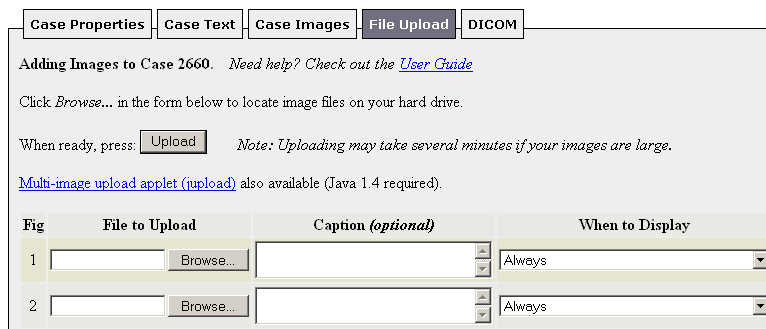
• To specify the location of an image to upload, click the first Browse... button under the Source column, which will launch a Choose file popup:

• This popup window may look slightly different from the one displayed above, depending on your operating system. You will see either thumbnails or icons representing the files in a folder on your hard drive. To look in a different folder, click the folder name (e.g. "Sample Images" in the example above), and navigate to the desired folder from the drop-down tree menu:
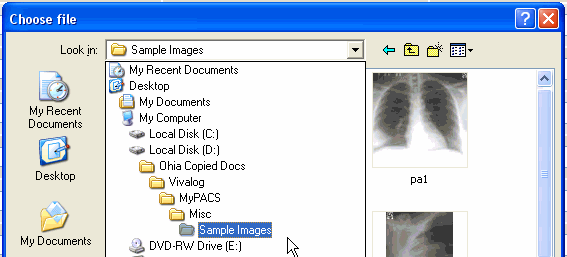
• Once you have located the desired file to upload, double-click on the file icon or thumbnail, which will select that file and close the popup window, returning you to the Add Images form. You may optionally enter a caption for the image. The caption may simply identify the image parameters (e.g. "Axial Pre-Contrast T1"), or you it can include a paragraph describing the findings in the image. The caption will not appear when the user is viewing the case as an unknown during Training Mode, so it is safe to include findings in the caption. You do not need to enter a figure number, as those will be automatically generated.

• If you want to control when the image is displayed (the default is Always), specify the criteria using the drop-down menu under "When to Display":
The choices are:
- Always: the image will appear regardless of what stage of training mode the user is in. This is the most common setting.
- Always except during "View as Unknown": the image will be omitted during the first stage of training mode. This is useful for images that explicitly reveal findings, such as close-ups or images marked with graphical annotations (e.g. arrows pointing out findings).
- Only during "View as Unknown": the image will only appear during the first stage of training mode. If you have two copies of an image (one that is marked up with graphical annotations), you can use this setting to have annotations effectively turn on or off as the user switches between stages of training mode. Upload the two images in adjacent positions, then set the annotated image to display "Always except during View as Unknown" and the non-annotated image to display "Only during View as Unknown".
- Only during "Reveal Findings & Captions": the image only appears during the 2nd stage of training mode.
- Only during "Reveal Full Case": the image only appears during the final stage of training mode.
You can also upload an entire folder of images by using the Multi-Image Java Applet. Click the link shown below inside the red oval.
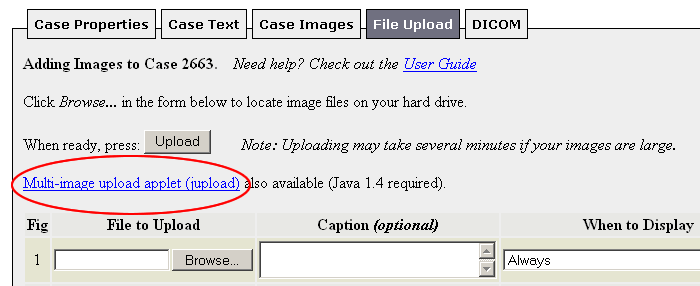
• After clicking the applet link from the file upload form a window will pop up asking you confirm the security of the program. Click "Yes" to run the applet.
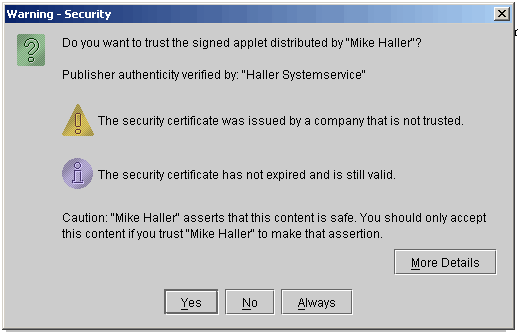
• To specify the location for a folder of images to upload, press "Add Files" (shown in the red oval below) which will launch an Add Files popup:
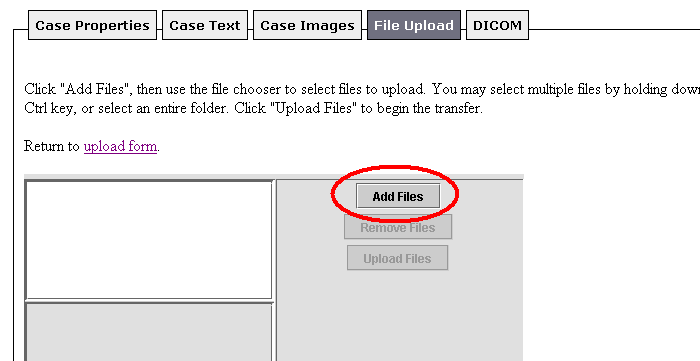
• This popup window may look slightly different from the one displayed above, depending on your operating system. You will see either thumbnails or icons representing the files in a folder on your hard drive. To look at a different folder, click the folder name (e.g. "My pacs" in the example above), and navigate to the desired folder from the drop-down tree menu:
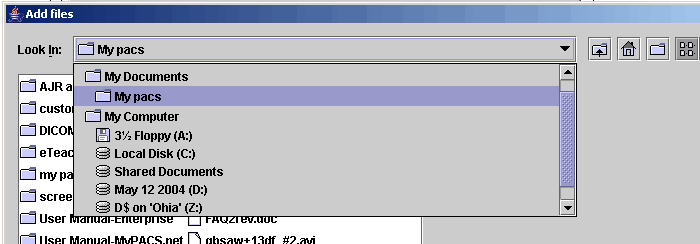
• Once you have located the desired folder or file to add, single-click to select it, and then press "Add Files".

• The files within the folder you selected are now listed. You can add another folder by pressing "Add Files" again, or you can remove individual files by selecting them and pressing "Remove Files". Once you have included all files to be added to the teaching file case press "Upload Files". Notice that the upload form tells you how many files are going to be uploaded as well as the storage size of all the files. Progress bars will show the process of uploading the files. After all the files have been uploaded the system will take you to the Case Images tab, where the images are displayed and you can add captions, reorder images, and set when images are displayed.
